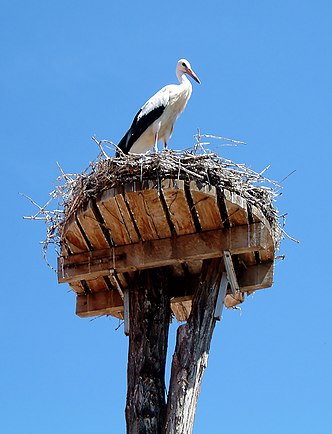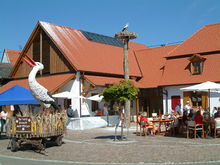Palatine stork campaign
| Aktion PfalzStorch e. V. | |
|---|---|
| purpose | Resettlement of the white stork in Rhineland-Palatinate |
| Chair: | Karl Wedges |
| Establishment date: | January 17, 1998 |
| Number of members: | > 200 |
| Seat : | Bornheim (Palatinate) |
| Website: | www.pfalzstorch.de |
The PfalzStorch e. V. (according to its own spelling), based in the southern Palatinate wine-growing community of Bornheim ( Rhineland-Palatinate ), is a non-profit association that was founded in 1998 and - like the European stork villages - is committed to protecting the white stork in the near and far.
At its headquarters, Aktion Pfalzstorch operates the Storchenscheune Bornheim care station and - together with the local community - the first Rhineland-Palatinate stork center, the educational facility Storchenzentrum Bornheim . The Bornheim Stork Festival in summer is already a fixture with a nationwide appeal.
Geographical location
Bornheim is located near the eastern edge of the Palatinate Forest in the hilly foothills of the Palatinate wine-growing region . The town of Landau spreads to the west of the municipality , to the east the lowland of the Queich river , which is mainly used as grassland , defines the now flat landscape of the Upper Rhine Plain .
history
In the past, storks nested in every village on the Rhine plain, mostly on towers and roof ridges . In order to restore this state of affairs after several decades in which there were no storks, the Palatinate Stork was launched as an association in 1998. The founding chairman was the CDU member of the state parliament at the time, Dieter Hörner (1941–2014). One of the founding members, Gerhard Postel (1941–2012), who was apostrophized as “environmental pastor” , received the Federal Cross of Merit, 1st class , in 2010 . In 2013, one year after the death of the evangelical clergyman, Aktion Pfalzstorch donated the Gerhard Postel Nature Conservation Prize , which it has awarded annually since then.
tasks and goals
The association, which has more than 200 members, including around 30 communities and local nature conservation associations, endeavors to identify the similarities between nature conservation and landscape management and to take all aspects into account when it comes to restoring the best possible environmental conditions for storks.
Stork barn
In 1997, before the official founding of the association, the Pfalzstorch campaign opened the Storchenscheune Bornheim care station in a former agricultural property . The facility, which is located close to the center on the southern outskirts, has a large aviary in addition to the permanent building in which storks that are unable to fly or unable to fly can safely live and breed without interference . Also nestlings who have lost their parents are kept until they are in autumn pulling-away can connect storks.
In the local area, live cameras are aimed at the nests of wild storks that have been breeding here for years. The object known from the website as Nest 1 is located directly on the roof ridge of the stork barn. The location of the second camera is on the evangelical church in Bornheim, the third is on the aviary of the stork barn in the direction of the sports field, and a fourth is on the Zeiskamer mill in Zeiskam.
Stork center
The Bornheim stork center is a joint institution of the Bornheim community and the Pfalzstorch campaign. The association wants to provide information about the white stork and its regional habitats that are worth protecting, and to scientifically coordinate and document the species protection project. He uses a historical property from 1742, which is owned by the municipality and has been renovated and restored by the municipality. The building was inaugurated on March 4, 2006, and construction of the center began in 2007. In the end there should be three departments:
|
tourism
When the young ones take their first trips out of the nest, is since 2004 every summer the Bornheimer Stork Festival celebrated. It can u. a. Young stork sponsorships can be auctioned against corresponding donations . The festival has already developed into a tourist attraction that attracts visitors from all over Germany. Sometimes the guests even experience the landing of a stork that has just fledged from a short distance on the ground. Traditionally, art exhibitions take place in connection with the stork festival, e.g. B. 2006 in the Bornheim village community center with paintings by the American painter Jacklyn Gratzfeld, who lives in Germany .
The community of Offenbach an der Queich , to which Bornheim belongs, has designated two stork hiking trails that can be used by bicycle or on foot from central parking lots.
successes
Population increase
After three young storks were last hatched in the southern Palatinate in 1973, the Pfalzstorch campaign made a significant contribution in the first six years of its existence to the fact that the number of breeding pairs in Rhineland-Palatinate rose to 35 again from 1998 to 2004. The Rhineland-Palatinate focus of the breeding population lies in the Queich lowlands between Landau in the west and a line Bellheim - Zeiskam - Lustadt in the east.
In the following years, the stork population increased continuously not only in the Palatinate, but also in the entire state of Rhineland-Palatinate. In 2019, 360 breeding pairs were counted in the country, in whose nests 677 (2018 even 727) young storks were ringed.
Meadow irrigation
One of the main reasons for the above-average success in settling the white storks in the region is the resumption of meadow irrigation. The project Queich-Wässerwiesen to revive this centuries-old cultural landscape form results from the cooperation of communities, farmers and conservation organizations, and is unique to this extent in Rhineland-Palatinate. In the meantime, an attractive feeding habitat for the white stork has emerged on several hundred hectares . On the basis of historical water rights, there are staggered water dates on different meadow areas.
The meadow irrigation in spring causes a rise in groundwater , so that u. a. different earthworm species and the larvae of the meadow snake ( Tipula paludosa ) push upwards. This means that the hunting parent storks have a much larger supply available for feeding the chicks, which need fine, soft food in their first phase of life. Initially, small mammals such as mice , which leave their tunnels because of the rise in water, mainly serve to feed the adult birds themselves .
The watering dates in summer mean that impressive flocks of storks are attracted from a larger area, including the young storks that have already fledged. At this time of year, the moisture also drives locusts and other insects up from the lower grass layer and can be captured by the storks much more effectively.
Webcam access
For the installed ranging from Bornheim live nest cameras every year more than one million Internet hits instead. The Pfalzstorch campaign hopes that this will awaken and promote environmental awareness.
literature
- Michael Fangrath and Hans-Wolfgang Helb: The throat pattern of the white stork - an individual or gender-dimorphic characteristic? In: Ornithological Communications . 57th year, no. 5 , 2005, p. 148–153 ( pfalzstorch.de [PDF; 4.0 MB ]).
- Michael Fangrath and Pirmin Hilsendegen: The importance of the Queichtal as a resting and overnight area for the white stork (Ciconia ciconia L.): Sleeping places and origin of the birds . In: Communications from Pollichia . tape 91 for 2004 and 2005. Bad Dürkheim 2005, p. 171–178 ( pfalzstorch.de [PDF; 2.0 MB ]).
- Michael Fangrath and Pirmin Hilsendegen: Irrigation management for the white stork (Ciconia ciconia L.) in the Queich lowlands near Landau in the Palatinate . In: Communications from Pollichia . tape 91 for 2004 and 2005. Bad Dürkheim 2005, p. 179–192 ( pfalzstorch.de [PDF; 5.0 MB ]).
Web links
- Palatine stork campaign : Bornheim, barn roof (nest camera 1)
Individual evidence
- ^ Articles of Association. Aktion Pfalzstorch, accessed on April 25, 2012 .
- ↑ Very sad news - Gerhard Postel is dead. Pfalzstorch.blogspot.com, April 7, 2012, accessed on June 9, 2020 .
- ^ Nabu local group Neustadt first winner of the “Gerhard Postel Nature Conservation Prize”. metropolnews.info, March 6, 2013, accessed June 9, 2020 .
- ↑ What are we? Aktion Pfalzstorch, accessed on April 25, 2012 .
- ↑ Pfalzstörche-Flyer 1. (PDF; 1.1 MB) Aktion Pfalzstorch, accessed on April 25, 2012 .
- ↑ a b Nest cameras. Aktion Pfalzstorch, accessed on April 25, 2012 .
- ↑ Stork hiking trails. Aktion Pfalzstorch, accessed on April 25, 2012 .
- ^ Storks in Rhineland-Palatinate. Aktion Pfalzstorch, accessed on April 25, 2012 .
- ↑ Nest locations and breeding results. Aktion Pfalzstorch, accessed on April 25, 2012 .
- ^ First offspring among storks in the Palatinate. rtl.de, April 21, 2020, accessed June 10, 2020 .
- ↑ Wässerwiesen network. Aktion Pfalzstorch, accessed on April 25, 2012 .




